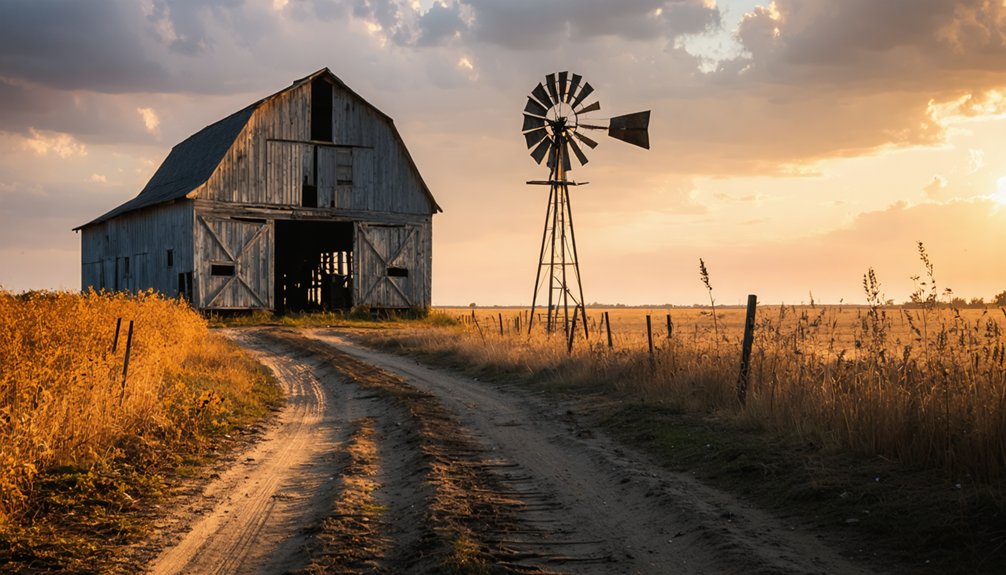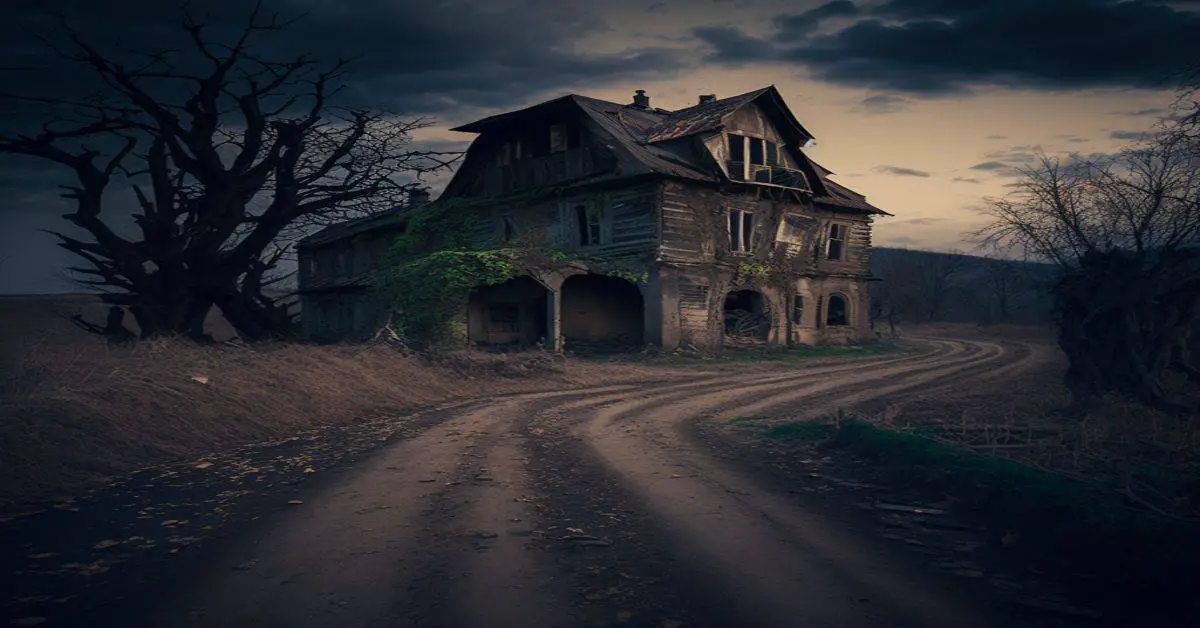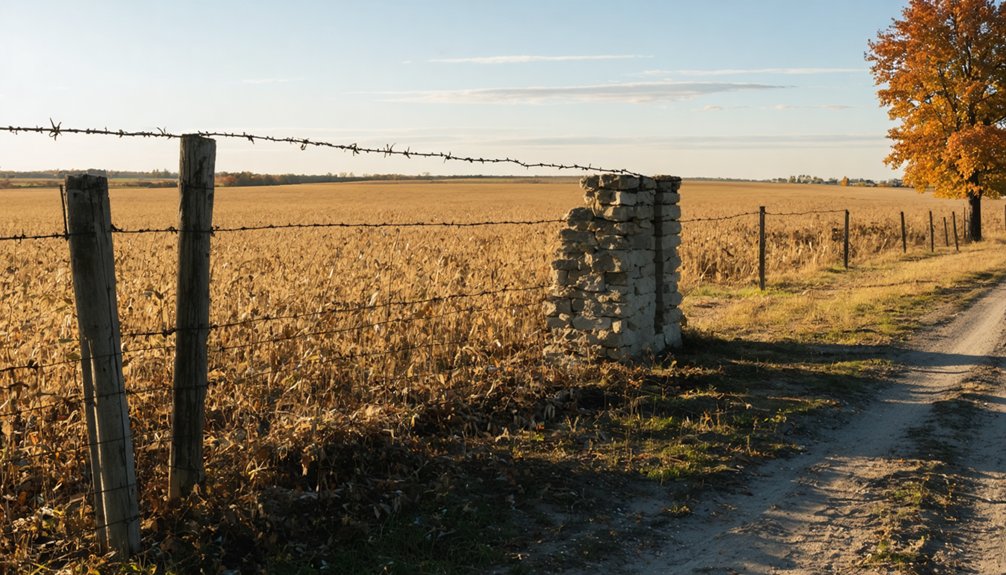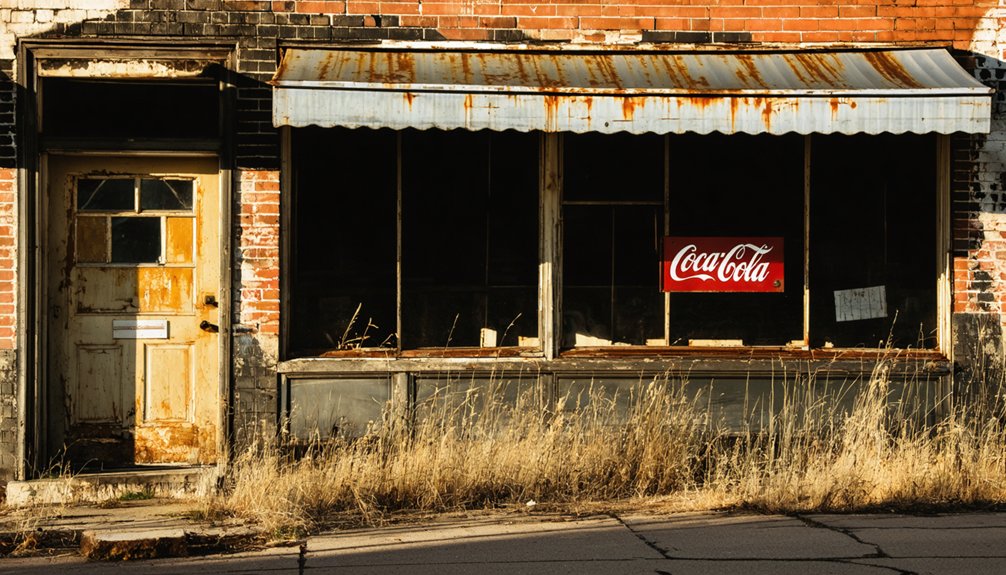You’ll find Bybee’s remains 2.7 miles south-southwest of Fairview, Illinois, where David Bybee donated land for a railway station in 1880. This prairie settlement grew around the Fulton County Narrow Gauge Railway, featuring a post office, school, and general store. By the early 1900s, track conversion to standard gauge and reduced train service led to the town’s decline. Today, only Bybee Cemetery stands as a silent witness to this vanished railway community.
Key Takeaways
- Bybee was established in 1880 when David Bybee donated land for a railway station along the Fulton County Narrow Gauge Railway.
- Located 2.7 miles south-southwest of Fairview, Illinois, Bybee developed as a small railway community with a post office and general store.
- The town’s decline began after 1910 when track conversion to standard gauge led to reduced train service and eventual abandonment.
- Today, only Bybee Cemetery remains as evidence of the former railroad community, with all original buildings and infrastructure gone.
- Economic changes and declining railway operations in the 1900s transformed Bybee into a ghost town in rural Illinois.
A Railway Town Takes Root
When David Bybee donated land for a railway station in 1880, he set the foundation for a new community in Fulton County, Illinois.
You’ll find this settlement nestled 2.7 miles south-southwest of Fairview and 7 miles west-northwest of Canton, where railway expansion transformed empty prairie into a bustling stop along the Fulton County Narrow Gauge Railway.
As tracks were laid and trains began rolling through, community growth followed naturally. The post office‘s first leader was William Bybee, appointed as Postmaster.
Like seeds scattered along iron rails, the arrival of trains brought inevitable sprouting of commerce and community.
You’d have seen the essential pieces of frontier life taking shape – a general store serving daily needs, a schoolhouse educating local children, and a post office established in September 1881.
The railway station became the heart of Bybee’s operations, with two daily trains connecting residents to the wider world by 1905. The narrow gauge tracks served the community until they were converted to standard gauge around 1910.
Life Along the Narrow Gauge
During the early 1900s, life in Bybee revolved around the distinctive rhythm of the Fulton County Narrow Gauge Railway‘s daily schedule.
You’d hear the trains chugging along at twelve miles per hour, winding through 183 curves as they connected you to Galesburg, Fairview, and Lewistown.
The railway’s impact touched every aspect of daily life – from the general store’s merchandise arrivals to your mail at the post office established by William Bybee in 1881. The narrow gauge rails, set just three feet apart, made the railway unique and earned it the nickname “the peavine” among locals.
By 1976, deteriorating track conditions forced trains to operate at reduced speeds of just 10 miles per hour.
The Rise and Fall of Bybee Station
The story of Bybee Station mirrors the arc of many small railway towns across Illinois. You’ll find its roots in David Bybee’s land donation for a station along the Fulton County Narrow Gauge Railway around 1880.
The town quickly established itself with essential services – a post office opened in 1881 with William Bybee as postmaster, while a school and store served the growing community. To maintain historical accuracy, researchers recommend direct linking to specific articles about Bybee Station rather than general disambiguation pages.
Like so many frontier towns, the heart of Bybee Station beat through its post office, schoolhouse, and general store.
Like Portland’s MAX Light Rail system that began in 1986, railroads were vital to small town development. In its heyday, Bybee’s railway impact was significant, with two daily trains by 1905 connecting local farmers to wider markets.
But the town’s fortunes changed after 1910 when the track converted to standard gauge. Service dwindled to one train daily by 1913, and eventual abandonment sealed Bybee’s fate.
Today, only the cemetery remains as a memorial to this vanished prairie community.
Legacy in the Prairie Landscape
As prairies vanished across Illinois, Bybee’s surrounding landscape transformed from a rich tapestry of native grasses and wetlands into agricultural fields.
Similar to nearby Pearl, which saw its population peak at 928 in 1890, Bybee experienced dramatic population changes as the landscape evolved.
You’ll find less than 1% of the original prairie ecosystem remaining today, though its ecological significance persists in protected conservation areas and nature preserves near former ghost towns like Bybee. Early settlers encountered these grasslands with both awe and fear, as the tall prairie grasses made navigation especially challenging.
The prairie’s legacy lives on through:
- Prairie restoration projects at sites like Midewin National Tallgrass Prairie, where native plants are being reintroduced
- Historical markers and cemeteries that tell stories of settlement and environmental change
- Local heritage initiatives preserving the cultural memory of how prairie life shaped early communities
These efforts reflect both the profound loss of biodiversity and the determination to reclaim essential ecosystem services that once defined Illinois’s natural heritage.
Traces of a Vanished Community
Looking across Bybee’s former site today, you’ll find few traces of this once-bustling railroad community beyond the historic Bybee Cemetery, also known as Hipple Cemetery.
The railway’s right-of-way, which once connected this significant stop to Galesburg and Fairview, has largely vanished beneath decades of farming and natural reclamation.
Like many ghost town histories, details of Bybee’s early development remain poorly documented due to its eventual abandonment.
A post office and blacksmith once served local residents during the town’s peak in 1880.
You won’t find any original buildings from the town’s heyday – no store, school, or train station where community memories were forged.
Economic shifts triggered by declining rail service in the 1900s sealed Bybee’s fate, as train frequency dropped from two daily stops in 1905 to just one by 1913.
When the tracks were finally torn out in the 1930s, they took with them the last remnants of Bybee’s railroad identity.
Frequently Asked Questions
Were There Any Notable Crimes or Incidents in Bybee’s History?
You won’t find any unsolved mysteries or historical crimes in the records – available sources don’t document notable incidents during Bybee’s years as an active railway stop and farming community.
What Was the Peak Population of Bybee During Its Most Prosperous Years?
You’ll find no exact records of Bybee’s peak population, but based on its railroad-dependent growth and economic decline, estimates suggest between 50-150 residents during its most prosperous years around 1905.
Did Any Famous People Ever Visit or Live in Bybee?
You won’t find any documented celebrity sightings or famous residents in Bybee’s history. The town’s historical significance remained limited to local families and railroad operations, without attracting any notable personalities.
What Happened to the Original Buildings and Structures After Abandonment?
Like 90% of Illinois ghost towns, you’ll find no building decay here – structures were dismantled after the 1920s railroad closure, with no historical preservation efforts. Only the cemetery remains today.
Were There Any Churches or Religious Organizations Established in Bybee?
You won’t find any church history or religious significance in this settlement – no churches or religious organizations were ever established according to available historical records and local documentation.
References
- https://drloihjournal.blogspot.com/2022/08/lost-towns-of-illinois-bybee-illinois.html
- https://www.youtube.com/watch?v=93k0qtvzkn4
- http://cantontornado36.blogspot.com/2017/04/ghost-towns-of-fulton-county-illinois.html
- https://drloihjournal.blogspot.com/p/lost-towns-of-illinois-series.html
- https://www.abandonedrails.com/fulton-county-narrow-gauge-railroad
- http://livinghistoryofillinois.com/pdf_files/Bybee
- https://en.wikipedia.org/wiki/List_of_ghost_towns_in_Illinois
- https://truwe.sohs.org/files/bybee.html
- https://www.ancestry.com/sharing/31225579?h=a27511
- https://idot.illinois.gov/content/dam/soi/en/web/idot/documents/transportation-system/maps—charts/railroad-maps/1928-historic-rail-map.pdf



